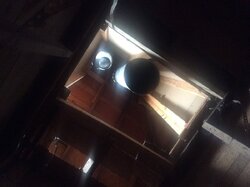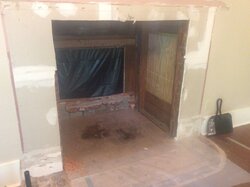We purchased our home a year and a half ago. Our house was originally built in 1912, and 25 years ago, it was moved to the present location. The original brick chimneys were back to back - one facing the living room, the other the master bedroom. The previous owner had two sheet metal fireplace inserts installed back to back.
We did not use them during our first winter because they just didn't look right to me. We got them inspected last summer, and the chimney sweep company mailed our check back to us. They wanted nothing to do with the fireplaces. They were installed improperly and dangerous. I removed both of them, and now I have a big cavity in the wall that I would like to convert into an alcove for a wood burning stove.
I got a good deal on a Dutchwest 2462 (catalyst) last summer. I can create all of the proper clearances on the sides of the opening, but I'm not sure how high to go with the alcove ceiling. I called Dutchwest today, and the tech guy wasn't sure either. He suggested at least 54" above the stove.
I want to pour a 3" concrete (tinted) slab on the floor and line the bottom 5' with brick. I'll have cement board behind the brick, and continuing up to the ceiling of the alcove. We have 12' ceilings, so there's plenty to work with on height. I am going to widen the opening to make it 6', which will provide the correct side clearances.
I just want to see if my thinking is right on this. I want it to be safe. Any feedback will be appreciated.
We did not use them during our first winter because they just didn't look right to me. We got them inspected last summer, and the chimney sweep company mailed our check back to us. They wanted nothing to do with the fireplaces. They were installed improperly and dangerous. I removed both of them, and now I have a big cavity in the wall that I would like to convert into an alcove for a wood burning stove.
I got a good deal on a Dutchwest 2462 (catalyst) last summer. I can create all of the proper clearances on the sides of the opening, but I'm not sure how high to go with the alcove ceiling. I called Dutchwest today, and the tech guy wasn't sure either. He suggested at least 54" above the stove.
I want to pour a 3" concrete (tinted) slab on the floor and line the bottom 5' with brick. I'll have cement board behind the brick, and continuing up to the ceiling of the alcove. We have 12' ceilings, so there's plenty to work with on height. I am going to widen the opening to make it 6', which will provide the correct side clearances.
I just want to see if my thinking is right on this. I want it to be safe. Any feedback will be appreciated.



